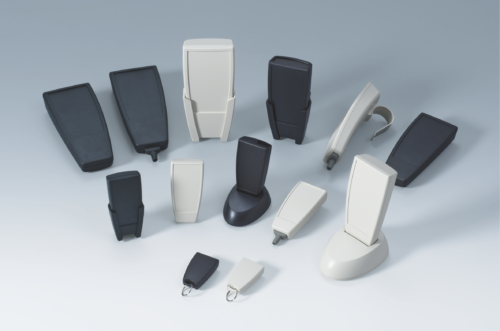New technology, superior plastics, and a wider choice of standard enclosures address challenges set by the medical sector.
Healthcare has always been a demanding area of business for the electronics industry, not least because human lives are at stake. This sector expects excellence as standard—setting the bar high for all medical devices—no matter what their function.
Hospitals and other clinical environments may take wonderful care of their patients, but the electronic devices that aid in their recovery may be destined for a much tougher time. They may be used around the clock by multiple clinicians, including those still undergoing training.
As a result, products (and their enclosures) must be tough and reliable, and they must continue to look new, modern, and dependable throughout their operational life. After all, who would want to be treated in a hospital with old and battered equipment?
And, as if these challenges were not enough, the healthcare sector always keeps a close eye on its budgets. So, hospitals want the best of both worlds: new technology at keen prices. In the past, this posed an issue where enclosures were concerned; bespoke plastic housings can be expensive because of the tooling costs.
Fortunately for product designers, there are now more standard and customizable enclosures than ever to choose from. Many are highly specialized, with technical features designed to meet specific requirements, yet versatile enough to suit multiple applications.
Thanks to their smart designs, they require very little customization, and new technology means that whatever minimal modifications they do require can be carried out quickly and in lower volumes. This makes them perfect for the medical sector.
The hospital bedside is a key location for many medical devices. Adjustable beds need remote controls, usually wired. OKW’s SMART-CASE is perfect for this application. SMART-CASE (IP 65 optional) continues to be one of the manufacturer’s most popular models, selling particularly well last year. It is robust, comfortable to hold, and is supplied with a choice of either a pre-fitted cable gland or a battery compartment. Most of these enclosures are molded from ABS, but infrared-permeable PMMA is also available for wireless remote-control applications. There is also a range of hospital-centric accessories such as bedrail clamps, wall holders, and belt/pocket clips.
Desktops are another important location, especially for larger instrumentation. MEDITEC is designed specifically for this role, and it takes the brief a stage further by offering a version with a bail arm. This adjustable arm doubles as a desk stand, making it easy to position the enclosure at the perfect angle for viewing and operation.
MEDITEC’s four plan sizes accommodate Eurocard-sized PCBs (double and extended), and side panels can be added to increase enclosure height and capacity. Clip-in side trims in a choice of colors make it easy to specify added ventilation if needed.
Meanwhile, SMART-CONTROL (IP 55 optional) exemplifies a whole host of developments in the world of plastic enclosures. Wedge-shaped SMART-CONTROL is designed for corner-based electronics but—thanks to some smart design—these enclosures are also suitable for desktop use. (A wall suspension element and a desktop stand are both available as accessories.) And then there are two big clues that this is a newer model…
The first clue is the material. Rather than ABS, SMART-CONTROL is molded from ASA+PC-FR as standard. This high-performance plastic combines the UV stability of acrylonitrile styrene acrylate (aka acrylic styrene acrylonitrile) with the strength of polycarbonate, which is used in riot shields and CDs. ASA+PC-FR’s flammability rating is also higher: UL 94 V-0 versus UL 94 HB for ABS.
The second clue is the fact that these enclosures are assembled with tamperproof Torx screws as standard. This a key requirement for medical electronics. But it’s not a dealbreaker for enclosures that don’t have them as standard because they’re easily specified as a custom option.
Handheld and wearable devices play a widespread and crucial role in clinical settings. The sheer number and diversity of applications has prompted the development of a wide range of models for these purposes.
Award-winning BLOB (IP 54 optional) handheld housings challenge a key design rule—that standard enclosures should not be too distinctive. The BLOB range’s three amorphous shapes—UNIT, CONTROL and PANEL—are a world away from the conservative square boxes of traditional enclosures. These unusual but highly ergonomic shapes are designed to guide the user’s fingers towards controls, making the devices they house very easy and intuitive to use. For this reason, BLOB is ideal for users with reduced grip or limited dexterity.
Another award-winner is MINITEC—personal electronics enclosures that can be worn around the neck or wrist, clipped to a belt or pocket, attached to a key ring, or carried loose. This model combines a top and bottom section with a choice of soft-touch intermediate rings to create a huge range of standard combinations based on shape (teardrop D or rectangular E), size, color, material (ABS or PMMA) and ring type (including USB).
Meanwhile, ERGO-CASE (IP 54 optional) can be worn on the arm, chest, wrist or around the neck—courtesy of a range of enclosure sizes and accessories that include belt straps, a wrist strap, lanyards, and belt/pocket clip. The enclosures can also be attached to walls.
As OKW Enclosures VP Marketing Robert Cox says: “The last few years have seen significant developments in enclosure design, giving a wider choice of new housings and rejuvenating popular existing models. Customizing services now include machining, lacquering, decor foils, laser marking, digital printing, and special materials. These services are now often available in lower volumes, thereby making customization more viable.”

